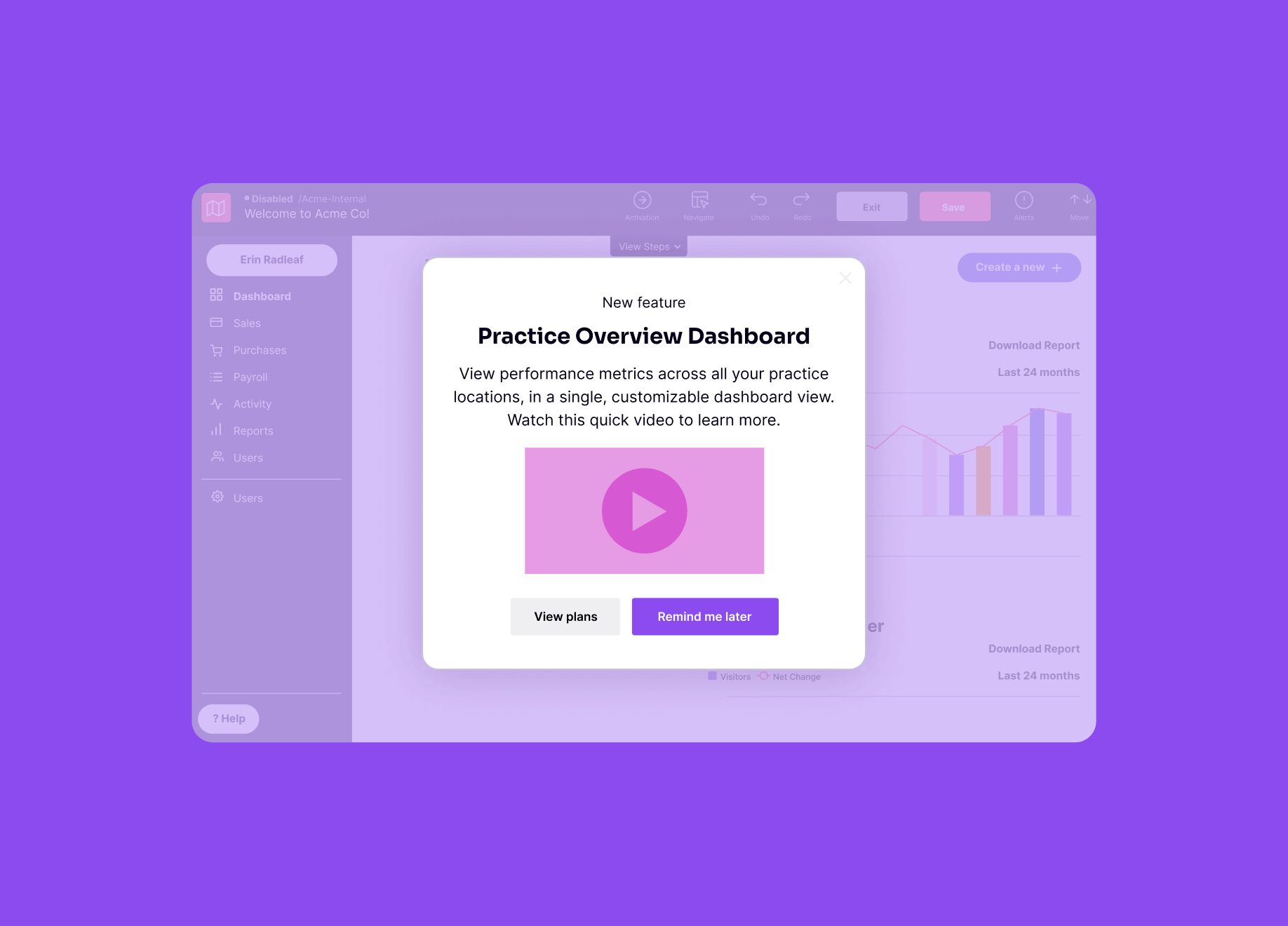
Digital adoption
The state in which users are able to leverage digital tools (software products, apps, websites, etc.) to the fullest extent.
Last updated: April 24, 2024
Dive deeper
Table of Contents
What is digital adoption?
Digital adoption is the process by which users learn to leverage new technology (software products, apps, websites, etc.) to its fullest potential and derive maximum value from a digital process or solution.
Digital adoption is human-centric, focusing as much on those who use the technology as much as the technology itself. It aims to increase productivity, improve user experiences, and optimize software. A successful digital adoption strategy sits at the intersection of these three pillars and culminates in an effective, mature digital workplace.

Why is digital adoption important?
In today’s rapidly evolving digital landscape, embracing new technologies and processes is no longer optional. It’s essential for business survival and growth. Consider the consequences to organizations without digital adoption.
- Digital disruption continues across every industry, but companies risk falling behind competitors with digital adoption strategies that allow them to improve efficiency, enhance customer experiences, and gain a competitive edge.
- Companies with low digital maturity experience a significant productivity gap compared to their more digitally advanced counterparts, translating to lost revenue and missed opportunities.
- Without the skills or support to effectively utilize new technologies, employees experience frustration and disengagement — leading to higher turnover rates.
- And since digital technologies are constantly evolving, companies that struggle with digital adoption miss out on the chance to leverage these advancements for innovation, product development, and improved customer service.
According to a 2021 report from Harvard Business Review Analytic Services sponsored by Pendo, 89% of executives say that driving the adoption of employee-facing software is a priority, but only 30% say their organization is highly effective at doing it. The other 70% risk:
- Increased operational costs due to inefficient workflows and manual processes
- Loss of market share to competitors who actively leverage technology to boost sales
- Employee disengagement and attrition due to outdated tools and lack of training
- Reduced agility and innovation, without which they cannot adapt to a fast-changing landscape.
To mitigate these risks and unlock a path to sustainable growth and success, companies must ensure the digital tools they procure are adopted by their users, whether those users are their employees or customers.
What are the main categories?
Most digital adoption initiatives will fall into one of two categories:
Customer-facing digital adoption
Customer-facing focuses on driving user engagement with customer-facing products or applications. Its goals include higher user satisfaction, increased product usage, and, ultimately, customer retention. For example, when launching a new mobile app or software features, customer-facing strategies ensure users can easily navigate the app or understand how to discover and use the latest features, thereby embracing them.
Employee-facing digital adoption
Employee-facing digital adoption focuses on ensuring employees understand and effectively use internal software and tools to improve workflows, boost productivity, and achieve business goals faster and with less friction. For example, when deploying a new ERP system, an employee-facing strategy should make onboarding employees to the new platform as painless as possible.
What are the benefits of digital adoption?
One of the most obvious benefits of digital adoption is increased ROI for the technology your company builds or buys. However, the successful adoption of digital tools goes beyond that and generates positive impacts across the entire business.
Digital adoption is also about empowering your workforce to leverage these tools effectively, transforming how your business operates and interacts with customers. When users (whether customers, employees, or both) maximize the value of their technology, they are happier, more productive, and more likely to remain users. Here are some of the most common benefits of:
- Improved workflows and internal efficiency — Imagine using a new project management tool to streamline team communication and collaboration, allowing for real-time updates, task delegation, and centralized file storage. This tool can eliminate lengthy email chains, scattered documents, misunderstandings, and errors, leading to faster completion of projects.
- Increased productivity — Adopting digital tools can automate repetitive tasks, freeing valuable employee time for more strategic work. For example, automated marketing campaigns or data entry tools can significantly reduce the time spent on mundane activities, allowing employees to focus on tasks that require creativity and critical thinking.
- Less user frustration with technology — Struggling users can quickly become overwhelmed and abandon new systems, hindering adoption and ROI. Digital adoption strategies like clear guides and in-app support minimize frustration and encourage continued engagement.
- Higher customer and employee satisfaction — Customers who can easily use a product or service are more likely to be satisfied and loyal. And empowered employees who can use a technology effectively experience greater job satisfaction and contribute more to the company.
- Reduced costs — Extensive training, errors, and rework can significantly increase operational costs. Digital adoption helps companies maximize their technology investments by minimizing training needs, streamlining processes, and reducing errors.
- Data-driven decision-making — Digital tools generate vast amounts of data on customer behavior, operational performance, and market trends. By leveraging analytics platforms, businesses can gain valuable insights to inform strategic decision-making and identify areas for improvement.
What’s the difference between digital adoption and digital transformation?
While “digital adoption” and “digital transformation” are often used interchangeably, there’s a critical distinction between them.
- Digital adoption refers to successfully integrating and utilizing new digital technologies within an organization. It ensures users (customers or employees) embrace and effectively use the latest tools and processes.
- Digital transformation is a much broader concept that encompasses the complete overhaul of an organization’s operations, culture, and business model to leverage the power of software and other digital technologies. It involves not just adopting new tools but also reimagining and optimizing how work gets done.
In short, digital adoption is a crucial part of digital transformation, using software to adapt to evolving demands. For example, if a software solution were to replace manual processes, full digital adoption would only occur once employees shift from their once-manual processes to the new digitally enabled state.
What role does digital adoption play in digital transformation?
In a company where employees successfully adopt workplace software, digital transformation efforts are much likelier to succeed. Successful digital transformation, among other elements, means employees become confident and empowered to use the digital tools to help them thrive in the workplace. It’s also a process in which employees become a part of the change itself, providing business technology and ops managers with critical feedback and demonstrating new and better ways of working that can inform how they plan digital change for the better going forward.
What are some examples?
What successful digital adoption looks like can vary widely depending on the nature of a company and its goals. However, it always involves employees or customers or both embracing the digital tools they are provided, and it ends with elevated user experiences and stronger business outcomes.
For example, JLL, one of the foremost commercial real estate companies, successfully drove awareness and adoption of new features on internal-facing market research and data-visualization apps using in-app notifications and robust analytics. In doing so, they closely tracked user satisfaction with these apps and were able to improve ratings over time. Essity, a leading global health and hygiene company, was able to drive digital adoption by automating onboarding for its users and using in-app guidance to walk its sales employees through essential processes.
These examples and countless other success stories highlight how digital adoption goes beyond acquiring new technology. Equipping users with the right tools and training makes them active participants in a company’s digital transformation journey. This fosters innovation, empowers employees, builds customer loyalty, and ultimately leads to a more competitive and successful organization.
How can I increase digital adoption?
In addition to ensuring a product is as intuitive as possible, there are specific strategies to help increase digital adoption across a company’s user base:
- Onboarding: By creating an effective onboarding strategy, companies can ensure users — employees or customers — become proficient in an application as quickly as possible and recognize its value, driving retention and preventing churn. For example, you can provide:
- Tailored experiences: Create different onboarding experiences for new users based on their roles and needs.
- Interactive tutorials: Go beyond static text instructions and provide interactive tutorials, walkthroughs, or short videos to guide users through key features.
- Clear value proposition: Communicate the value proposition of the software app and how it benefits users in their daily tasks.
- Measurable outcomes: Track key metrics during onboarding, such as time to complete tasks, to identify areas for improvement.
- In-app guidance: Beyond onboarding, users need contextual information while using the product. Many companies use in-app messaging to communicate at the right moments and guide users to success. Cartegraph uses in-app messages to drive behaviors in their app that lead crews to complete fieldwork more efficiently. Six months after launching these guides in their mobile app, the team saw a 62% increase in mobile adoption. Other helpful features might include:
- Contextual walkthroughs: Trigger short, interactive walkthroughs based on user actions or specific features the user is accessing.
- Tooltips and cheat sheets: Offer quick, contextual tooltips and cheat sheets that provide easy-to-access reminders and guidance within the application.
- Search functionality: Implement a robust search function within the app to allow users to find answers to their questions quickly and efficiently.
- Ongoing education: Since digital adoption is a continuous process, it’s vital to keep users engaged and informed with ongoing educational resources after onboarding is complete, especially when there are any product releases, changes, or updates. Some tactics include:
- Regular webinars and training sessions: Host regular webinars or training sessions to highlight new features, address common questions, and showcase best practices.
- Knowledge base and user guides: Develop a comprehensive knowledge base and user guides that provide easy-to-find documentation and resources for ongoing reference.
- Change management communication: Communicate product updates, changes, or new features through multiple channels to ensure users are aware of ongoing improvements.
Many companies are turning to digital adoption platforms to implement these practices effectively. These platforms can help automate tasks, personalize the user experience, and track progress toward digital adoption goals.
How can I measure digital adoption?
Digital adoption of internal software is typically measured by increased employee productivity, whereas customer-facing digital products are measured against various business KPIs and, for sophisticated organizations, product experience targets.
Key metrics for measuring
Measuring digital adoption success requires tracking critical metrics for both internal (employee-facing) and external (customer-facing) users. Here are a few metrics you’ll want and how to track them. (Note: An effective digital adoption platform can track and record these automatically.)
Employee-facing metrics
- Login frequency and active users
- How to track it: Measure the number of users logging in and actively using the software over time.
- Why it’s important: It can indicate user familiarity and engagement with the new tool.
- Task completion rates
- How to track it: Monitor the percentage of users completing specific tasks within the software.
- Why it’s important: It helps identify areas where users might need additional training or support.
- Time spent on tasks
- How to track it: Analyze the average time users spend completing specific tasks within the software.
- Why it’s important: A decrease in time spent can indicate improved efficiency and proficiency.
- Help desk tickets and user feedback
- How to track it: Measure the number of help desk tickets related to the new software.
- Why it’s important: User feedback can help identify areas of confusion or difficulty.
Customer-facing digital metrics
- Active users and feature adoption
- How to track it: Track the number of users actively engaging with the application and the specific features they utilize.
- Why it’s important: It provides insight into user behavior and feature popularity.
- Conversion rates
- How to track it: Monitor the percentage of users completing desired actions within the application, such as making a purchase, subscribing to a service, or completing a registration form.
- Why it’s important: An increase in the completion of desired actions can indicate whether a recent change in user interface or marketing is effective.
- Time spent on features
- How to track it: Analyze the average time users spend on specific features within the application.
- Why it’s important: It can indicate user engagement and areas where they might find value.
- App ratings and reviews
- How to track it: Monitor user ratings and reviews on app stores or other platforms.
- Why it’s important: It helps gauge overall user satisfaction and identify pain points.
By tracking these metrics and analyzing the data, you can gain valuable insights into user behavior and identify areas for improvement in your digital adoption strategies. This ongoing process helps ensure your users get the most out of the technology, maximize its value, and achieve the desired business outcomes.
Where can I learn more about digital adoption?
For those looking to dig deeper into digital adoption and DAPs, Pendo has published information on how to operationalize driving digital adoption and measure results.
You might also like


